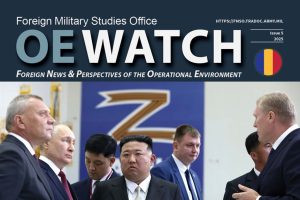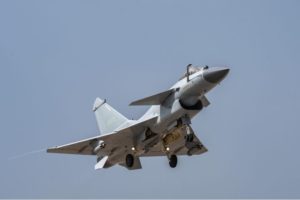
Kazakhstan’s Military Doctrine Raises Questions for Russia
By Matthew Stein
When Russia began its invasion of Ukraine in February 2022, the government of Kazakhstan immediately stated that it would remain neutral in the conflict. While the Kazakhstani government has stuck to this neutrality since the war began, it has also taken certain measures to distance itself from Russia’s militarism, including canceling its Victory Day Parade in May 2022 and suspending defense exports (including to Russia) in August 2022.

Flag of the Armed Forces of the Republic of Kazakhstan.
“Building up the radar field and increasing the potential and capabilities of the troops in conducting air and missile defense of the state…(and, the) development of the Unified Regional Air Defense System of the Republic of Kazakhstan and the Russian Federation.”
When Russia began its invasion of Ukraine in February 2022, the government of Kazakhstan immediately stated that it would remain neutral in the conflict. While the Kazakhstani government has stuck to this neutrality since the war began, it has also taken certain measures to distance itself from Russia’s militarism, including canceling its Victory Day Parade in May 2022 and suspending defense exports (including to Russia) in August 2022.[i] Thus, when Kazakhstan’s President Kassym-Jomart Tokayev approved a new military doctrine in October 2022, it drew attention to how Kazakhstan perceives various threats, with some speculation that Russia would be considered a threat without being named.
The accompanying excerpted article from Kazakhstan’s Russian-language independent newspaper Vremya reports on the changes in the doctrine since it was last published in 2017. The article reports that Kazakhstan has increased the combat potential of its units in “strategic directions,” and that it has created new units to combat disinformation. Although the article notes that a border conflict will be handled by the country’s border guards and the armed forces, it is unclear in the doctrine how a border conflict would different from other types of conflicts, such as an attack from another state. Another change in the doctrine is the development of special operations forces and an articulation on how they will cooperate with specialized units in other government agencies.
The new doctrine further notes that Kazakhstan will build capabilities in air defense, including in radar and missile defense. The doctrine references the “development of the Unified Regional Air Defense System of the Republic of Kazakhstan and the Russian Federation,” which is the only time that Russia is mentioned, suggesting Kazakhstan still sees Russia as a useful partner or at least does not wish to openly label it a threat. Other notable changes include equipping the border guards with modern systems as well as expanding production of basic types of ammunition for the armed forces. The Kazakh government established ammunition production as one of the early efforts to build the country’s defense industry, and this expansion of it could help Kazakhstan rely less on defense imports.
Sources:
“Токаев изменил военную доктрину Казахстана (Tokayev changed the military doctrine of Kazakhstan),” Vremya (a semi-independent Russian-language newspaper in Kazakhstan), 15 October 2022.
https://time.kz/news/politics/2022/10/15/tokaev-izmenil-voennuyu-doktrinu-kazahstana
President Kassym-Jomart Tokayev changed the military doctrine of Kazakhstan…
Some of the changes are aimed at replacing the word “heading” with “section”, as indicated in the quote, but the bulk of the changes have affected the fundamental formulations of the doctrine. The document contains exceptions to the old doctrine and additions to it…The further text of the changes approved by Tokayev, in addition to those already indicated in the quote are provided in full:
“Chapter 3. The current state of the military security of the Republic of Kazakhstan”; Paragraphs 18 and 19 shall be stated as follows:
The combat potential of the land, air force and naval component of the military organization of the state has been increased by creating the necessary set of troops (forces), weapons, military equipment and supplies in strategic directions.
Subdivisions have been created in the Armed Forces to organize counteraction to information-psychological and software-technical (cyber) influences in the troops. Work is underway to increase their potential and capabilities…
“Section 3. Basic Provisions”;
“Chapter 5. Vision in the field of military security and defense of the Republic of Kazakhstan”;
Paragraph 39 shall be amended as follows:
39. The resolution of a border armed conflict in the border space of the Republic of Kazakhstan is carried out by the Border Service together with the Aviation Service, the Border Academy of the National Security Committee of the Republic of Kazakhstan, other national security bodies in cooperation with the authorities, formations and military units of the Armed Forces and the National Guard of the Republic of Kazakhstan, if necessary, forces can be used and funds of other central state and local executive bodies.”…
“Chapter 6. Approaches to ensuring the military security of the Republic of Kazakhstan”;
Heading “3.3.1. Maintenance of combat readiness of the Armed Forces, other troops and military formations of the Republic of Kazakhstan” shall be stated as follows:
In paragraph 54: supplement with subparagraph 2-1) of the following content: “2-1) the development of the Special Operations Forces for effective operations in peacetime and wartime in cooperation with special forces units of other state bodies.”
Subparagraph 4) shall be stated in the following wording: “4) building up the radar field and increasing the potential and capabilities of the troops in conducting air and missile defense of the state…
Paragraph 57 shall be stated as follows: “1) development of the Unified Regional Air Defense System of the Republic of Kazakhstan and the Russian Federation…
Paragraph 61: subparagraphs 3), 4) and 5) shall be stated as follows: “3) equipping the Border and Aviation Services of the National Security Committee of the Republic of Kazakhstan with modern weapons and military equipment, technical means of border protection; 4) bringing the infrastructure of the State Border in line with its categorization and modern requirements; 5) increasing the efficiency of interaction between the Border Service of the National Security Committee of the Republic of Kazakhstan with central state, local executive bodies and the population of border areas in matters of protecting the State Border, including in the underwater environment of the Kazakh sector of the Caspian Sea”…
In paragraph 68: subparagraph 6) shall be stated in the following wording: “6) ensuring sustainability and expanding the production of basic types of ammunition for the Armed Forces, other troops and military formations”…
Notes:
[i] For more on the Kazakhstani government’s decision not to hold a Victory Day parade commemorating the Soviet Union’s victory over Nazi Germany in May, angering some in Russia, see: Matthew Stein, “Kazakhstan Cancels Soviet-Era Parade To Focus on Combat Readiness,” OE Watch, June 2022. For more on Kazakhstan’s suspensionvof defense exports for one year starting in August 2022, leaving Russia with one fewer supplier of weapons and equipment that closely matches its own armed forces, see: Matthew Stein, “Kazakhstan Suspends Defense Exports, Denying Russia Purchases,” OE Watch, October 2022. https://community.apan.org/wg/tradoc-g2/fmso/m/oe-watch-articles-2-singular-format/427937
Image Information:
Image: Flag of the Armed Forces of the Republic of Kazakhstan.
Source: https://commons.wikimedia.org/wiki/File:Kazakhstan_Armed_Forces_Flag.svg
Attribution: Public domain
Distribution A: Approved for public release
Categories:
Tags:
Related Products
Chinese Military Exercises Highlight Improvements in Joint Operations






